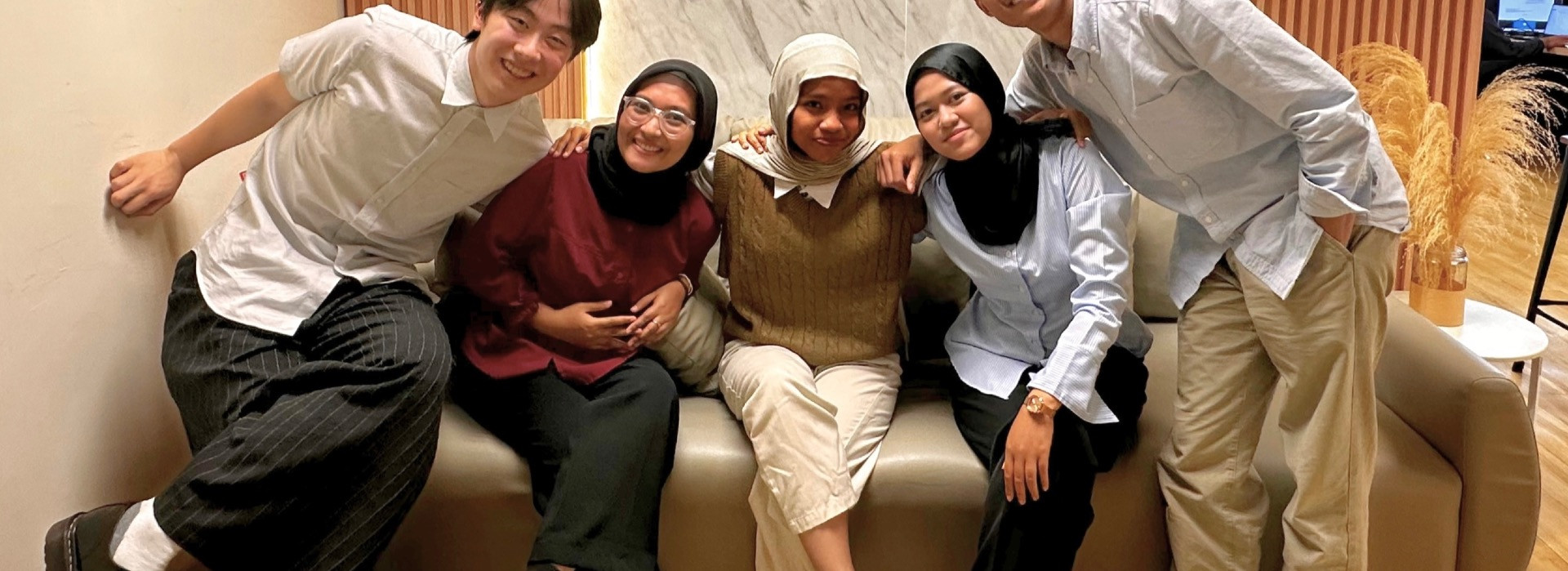Field, Forest and Future: Learning from Mangrove Restoration in Lampung
In June and July 2025, a group of student interns from IPB University and the University of Waterloo embarked on a unique journey to East Lampung, Indonesia. This journey is part of the Work-Integrated Learning (WIL) program, implemented by the IPB Centre for Applied Research in Nature-based Solutions (I-CAN) and supported by the FINCAPES Project. This immersive field placement allowed students to contribute to—and learn from—ongoing mangrove restoration initiatives in Purworejo Village and Pasir Sakti.
Over the course of several weeks, students took on diverse roles in biophysical, socio-economic, and ecological monitoring, collecting data, engaging with communities, and navigating unfamiliar environments—both ecological and cultural. What emerged wasn’t just data. The result was more a multidimensional narrative—linking scientific inquiry, social dynamics, and personal growth into a deeper understanding of what it means to restore ecosystems.
Measuring Mangrove Recovery: Biophysical Monitoring in Action
Monitoring mangrove growth is essential for understanding whether restoration efforts are succeeding. Iman Hamdi Aliwikan joined the biophysical team tasked with assessing mangrove health using field-based ecological indicators. Each day, the team measured seedling height, stem diameter, leaf count, and survival rate across different sections of the restoration area.
The results revealed notable differences between sites. One zone had tall, dense mangroves, while another showed sparse growth and higher mortality. These findings raised new questions about soil salinity, tidal exposure, and human disturbance—highlighting the importance of long-term observation.
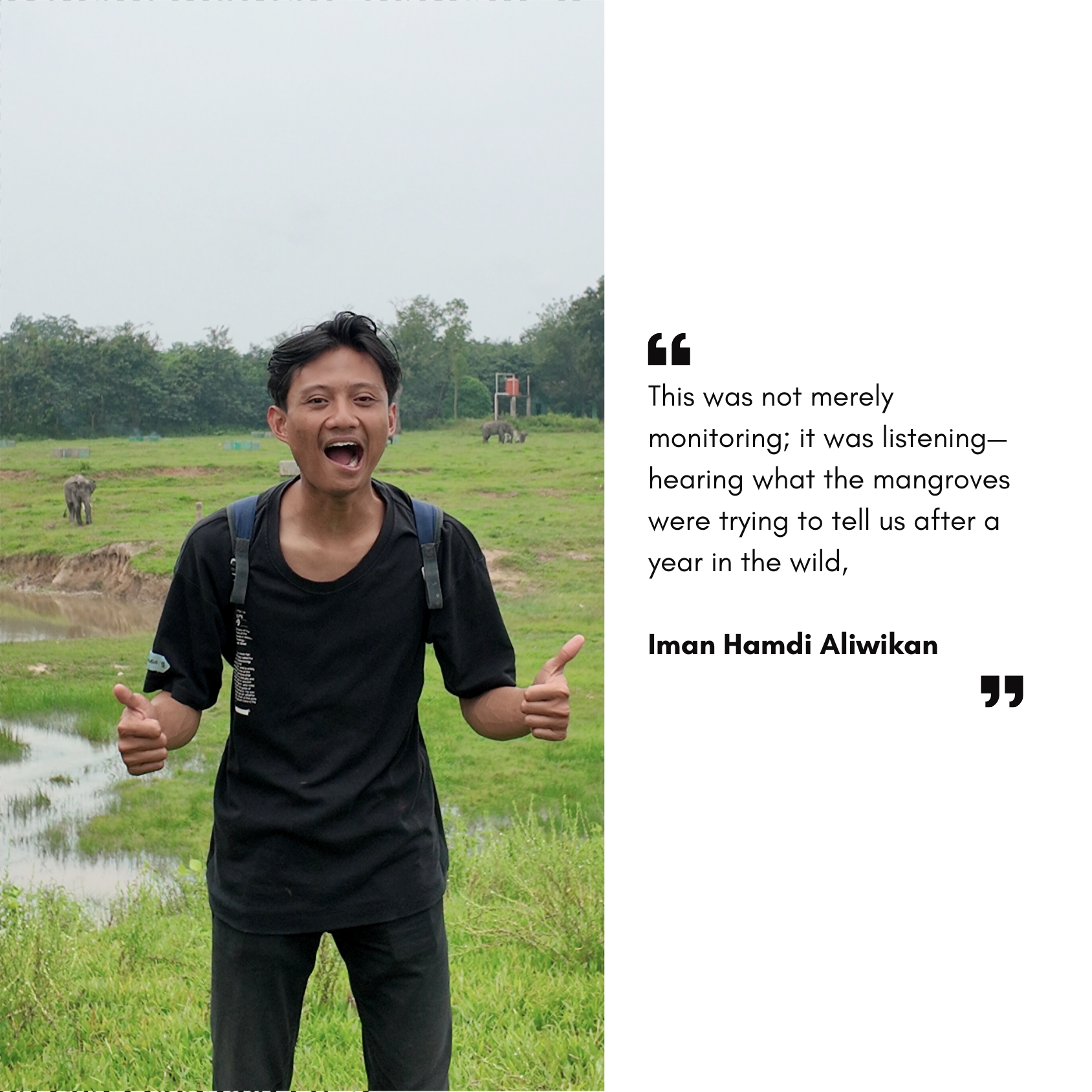
Biophysical monitoring provides crucial evidence for adaptive management. It helps identify what’s working, what’s not, and where interventions are needed to strengthen restoration outcomes.
Reading the Signs of Life: Fauna as Bioindicators
Sabilla Fatihaturrohmah took on the role of fauna monitoring assistant—tracking signs of life above and below the water. Sabilla’s work involved sampling macrozoobenthos, insects, birds, and nekton, each of which offers insight into the health of the mangrove ecosystem.
Bird presence, for example, suggests a stable nesting habitat. Nekton species like shrimp and fish indicate water quality and ecosystem productivity. The absence of these groups can point to environmental stress.
Sabilla also collected water and plankton samples to analyze nutrient levels and chemical conditions. These layers of data offer a more complete picture of ecosystem recovery.
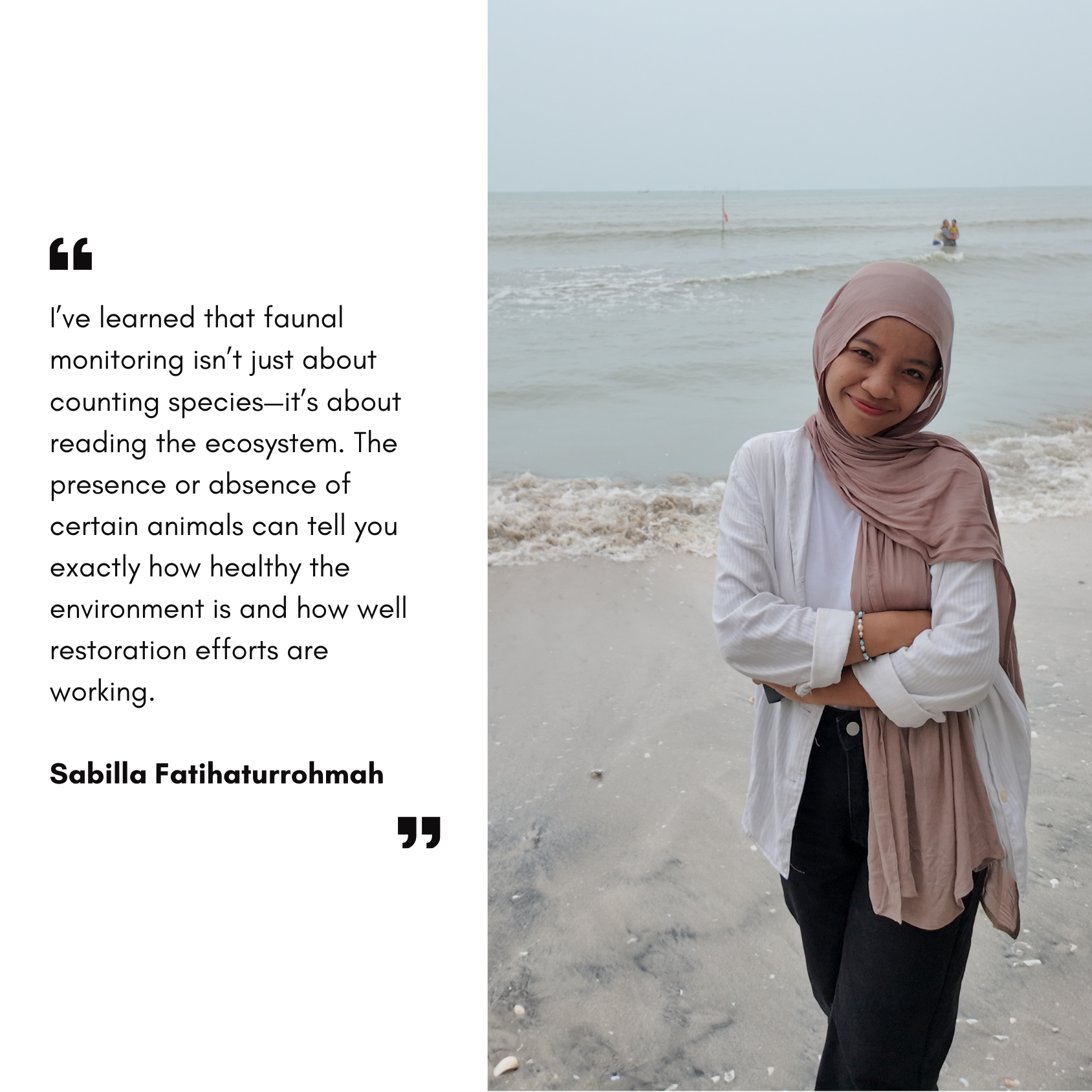
Community Conversations: Capturing Socio-Economic Impacts
Anisa Fitri Maharani joined the socio-economic monitoring team, engaging directly with residents in Purworejo Village. Through interviews and focus group discussions, her team assessed how restoration was affecting local livelihoods and perceptions.
The findings were encouraging. Many residents felt that mangroves had reduced coastal disasters and expressed interest in expanding their participation—particularly in skills training and market access for seafood products. Others shared aspirations for broader inclusion in mangrove-related activities.
Visits to NGOs and government offices in Bandar Lampung provided complementary perspectives on policy support and institutional roles.
Restoration impacts communities in multiple ways—ecologically, economically, and socially. Meaningful engagement and capacity building are essential for long-term success.
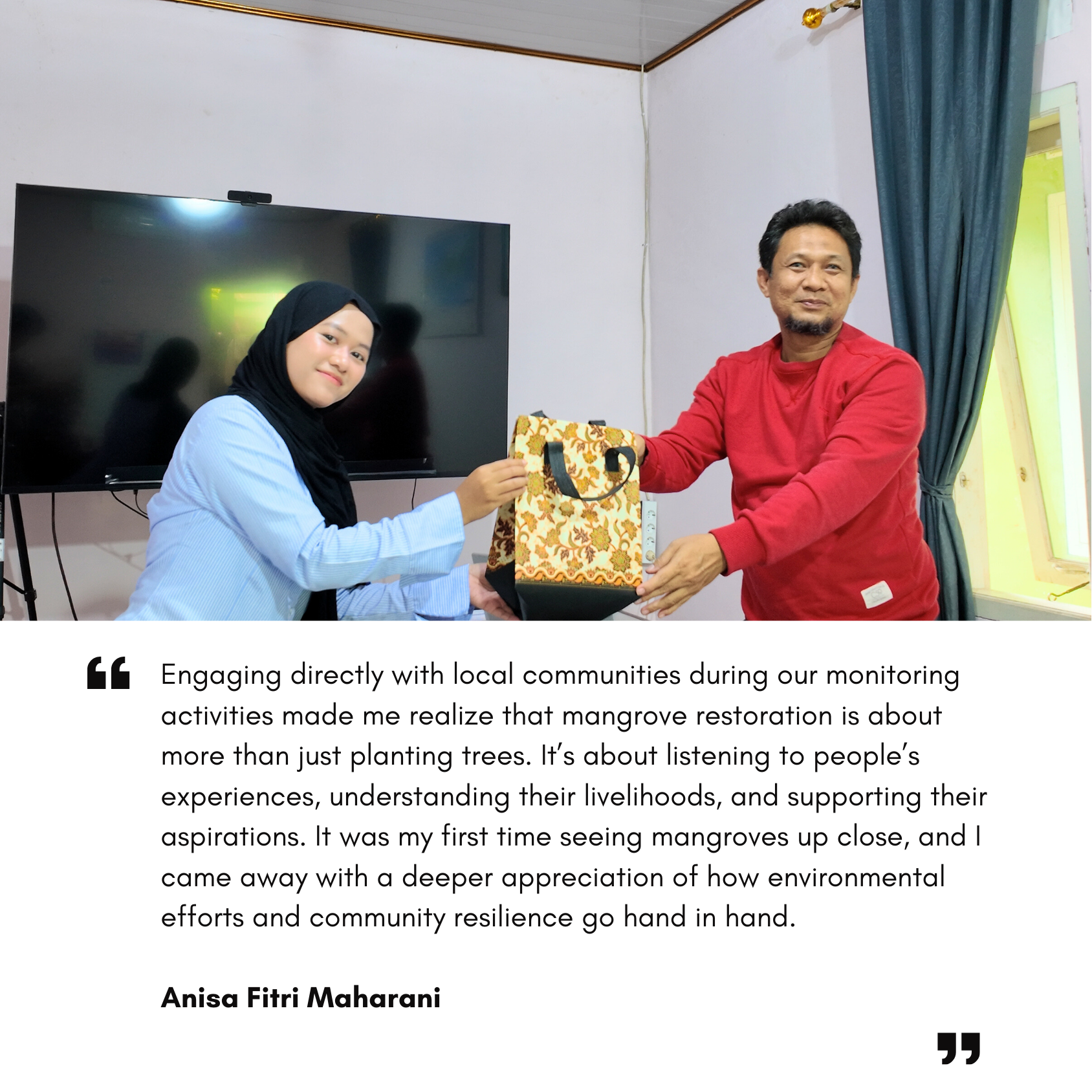 Equity in Action: Uncovering Gaps in Participation
Equity in Action: Uncovering Gaps in Participation
For Yuddit Syahfitri, the journey offered a distinct vantage point. As a member of the socio-economic monitoring team, her focus was not on measuring vegetation or tracking water quality, but on understanding the people who live alongside the mangroves—their livelihoods, perceptions, and aspirations.
During the team’s time in Purworejo Village, Pasir Sakti, Yuddit observed that ecosystem restoration is never just a technical process. It unfolds in the middle of communities, shaped by relationships, local knowledge, and often, unspoken dynamics. As interviews progressed, it became clear that while some groups like the KTH were actively engaged in restoration activities, many others, such as fishers, traders, and women outside formal networks, shared the same enthusiasm to be involved.
One conversation stood out. A local resident shared:
“If they had invited us, we would have gladly helped. This is our village too.”
To Yuddit, this was an invitation, a sign that people cared deeply about the coastline and wanted to be part of the solution.
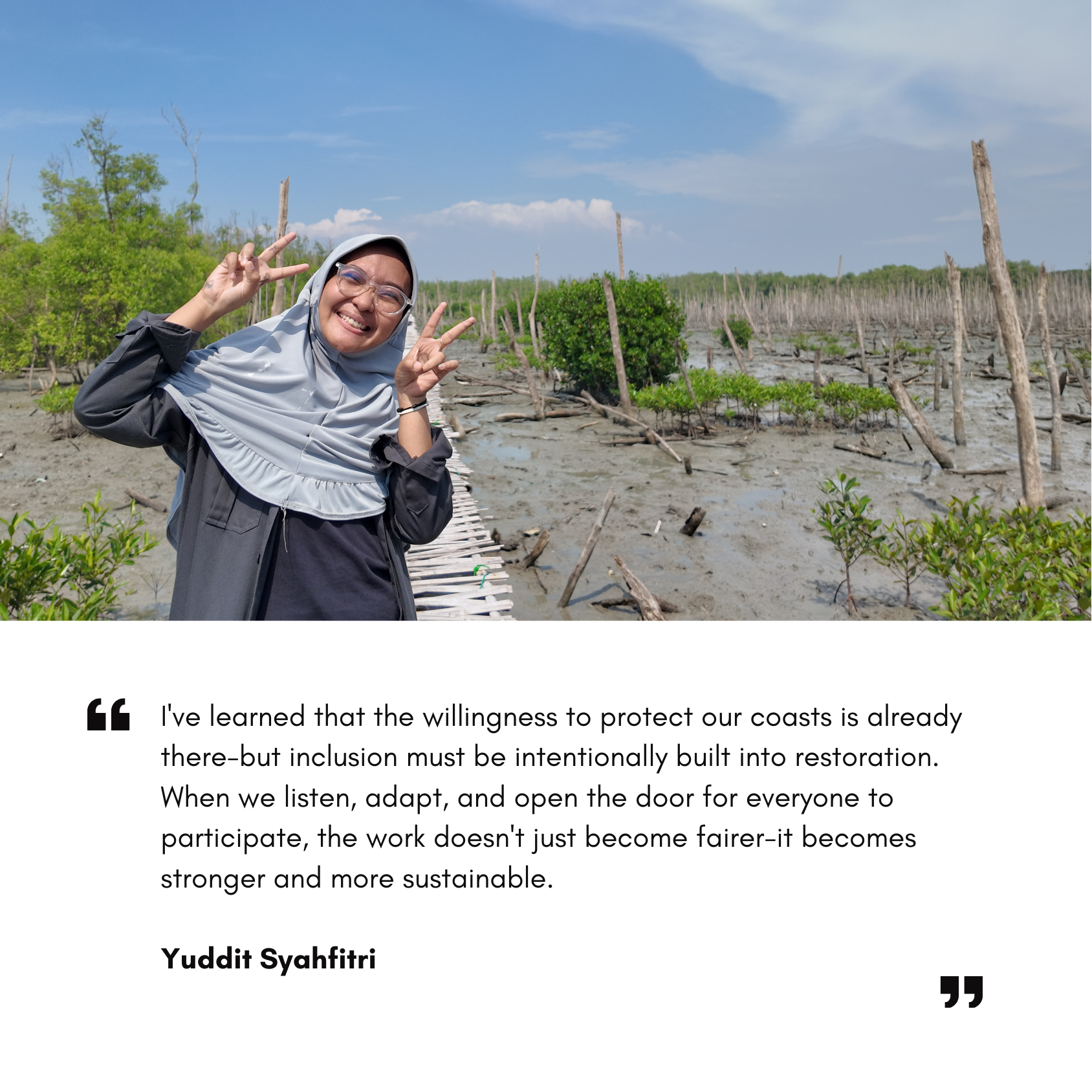 Throughout her fieldwork, Yuddit saw how access to opportunities, such as training, decision-making, and resources can vary across the community. She also noted how socio-economic factors like seasonal income, household roles, and market limitations influenced the way people participated in or benefitted from restoration initiatives.
Throughout her fieldwork, Yuddit saw how access to opportunities, such as training, decision-making, and resources can vary across the community. She also noted how socio-economic factors like seasonal income, household roles, and market limitations influenced the way people participated in or benefitted from restoration initiatives.
When Language Shapes Power: A Learning Curve in Two Languages
Not all challenges were technical. Raymond, a visiting student researcher from Canada, arrived in Lampung on his 49th day in Indonesia. By then, he had already explored much of Java, sampled local dishes like nasi padang and seblak, and picked up enough Bahasa Indonesia to navigate everyday life. He felt acclimated—until he entered the field.
Assigned to support socio-economic interviews in Purworejo Village, East Lampung, Raymond expected to lean on his past fieldwork experience in rural Uganda. But soon he found that conversational Bahasa Indonesia wasn’t enough. In the fast-paced, nuanced world of field interviews and stakeholder dialogues, words slipped past him. He could catch 80% of the conversation, but the most critical 20% such as the nuance and the core meanings, remained out of reach.
Though his team was kind and supportive, he often felt infantilized, cared for, but sidelined.
It wasn’t until the last day of fieldwork that things shifted. While interviewing a business representative in Bandar Lampung, Raymond discovered real-time voice translation tools that helped turn the conversation alive and he could fully engage, ask questions, respond with curiosity, and build a dialogue in real time. His natural inquisitiveness returned, and so did a powerful realization:
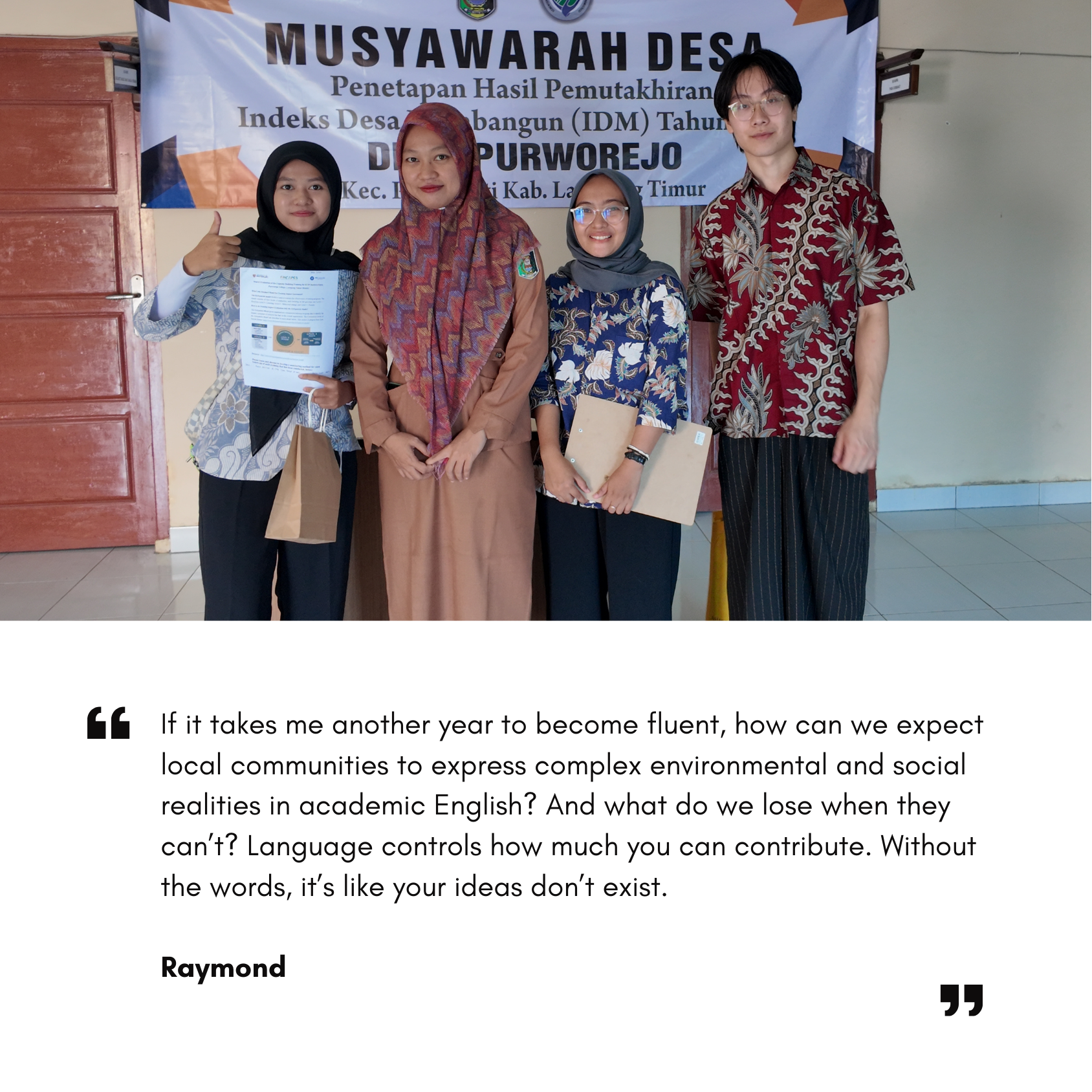 This experience led him to reflect not only on his personal limitations, but on broader patterns of power in development and research. In the global landscape, English is often the dominant language of science and collaboration—forcing many to work twice as hard just to be heard. His struggle mirrored what countless communities experience daily when expected to communicate their expertise in someone else’s language.
This experience led him to reflect not only on his personal limitations, but on broader patterns of power in development and research. In the global landscape, English is often the dominant language of science and collaboration—forcing many to work twice as hard just to be heard. His struggle mirrored what countless communities experience daily when expected to communicate their expertise in someone else’s language.
Raymond left the field with a deeper appreciation for the intelligence and insight that often go unheard, not because it’s not there, but because it’s spoken in a language others don’t bother to learn.
Linguistic inclusion isn’t just about courtesy, it’s about equity, agency, and knowledge justice. Collaborative research must recognize the power dynamics embedded in language. Tools, patience, and humility are needed to make space for all voices, not just the loudest or most fluent. Because true learning begins when we listen beyond words.
Data That Drives Decisions: Technical Monitoring Methods
Pungka Sihite was assigned to monitor the oceanographic aspects of the mangrove restoration site, but what he discovered went far beyond tidal charts and water levels. He was tasked to calculate mangrove density across three observation stations representing sparse, moderate, and dense growth. What began as a standard data collection assignment quickly evolved into a hands-on lesson in ecological complexity, field improvisation, and collaboration.
Armed with transect lines and quadrant plots, Pungka and the team measured vegetation in 10x10 meter plots for trees, 5x5 for saplings, and 2x2 for seedlings. They worked on both sides of the river to ensure a balanced dataset. By day four, forestry experts from IPSDH Jakarta and BPKH Lampung happened to visit the site. These unplanned encounters turned into mentoring moments, offering the students new perspectives on methodology and practical data collection.
In parallel with the vegetation survey, the group conducted a 24-hour tidal observation. Every hour, from 7:00 AM to 7:00 AM the next day, they recorded water levels. It was painstaking, sleep-deprived work—but it paid off. The data confirmed a diurnal tidal pattern, an insight with direct implications for mangrove zonation, sediment transport, and scheduling future restoration activities.
The mud was thick, the heat unforgiving, and the schedule tight—but none of it diminished the value of what Pungka experienced.
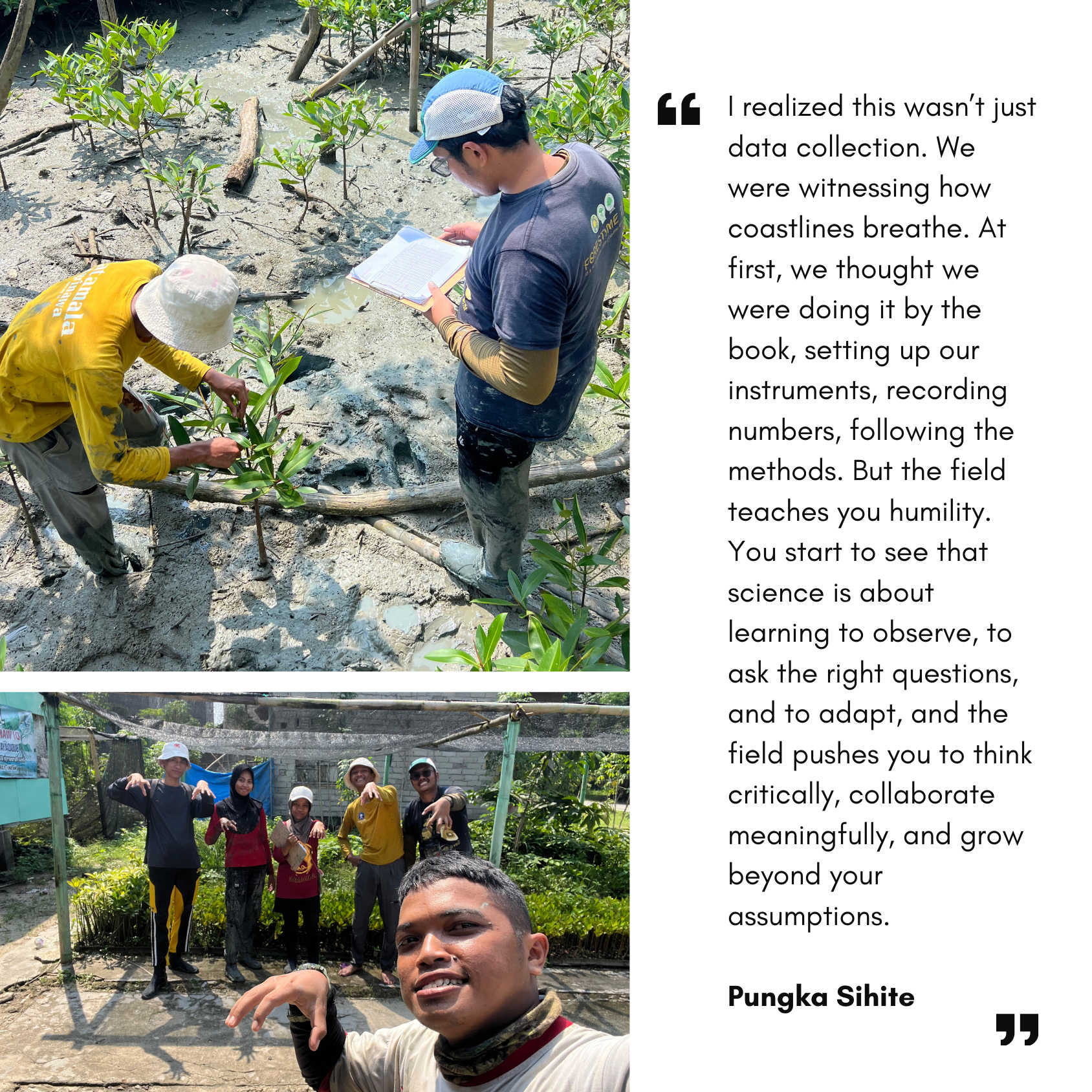
A Living Laboratory of Learning
Whether collecting samples, listening to community stories, or overcoming language barriers, each student discovered that environmental restoration is never a solitary task. It is a multidimensional effort that demands scientific rigor, empathy, and collaboration. These field experiences reaffirm a central truth: restoring ecosystems means investing in people, building inclusive systems, and staying open to learning at every step.
The Work-Integrated Learning program is one of I-CAN’s flagship initiatives, created to turn theory into practice. In Lampung, it became far more than a field placement—it was a convergence of disciplines, methods, and lived experiences: from mangrove roots to policy rooms, from meticulous scientific observation to moments of personal growth.
I-CAN, the IPB Centre for Applied Research in Nature-based Solutions, is being developed by IPB University with support from the Canada-funded FINCAPES Project. As a center of excellence, I-CAN serves as a living laboratory to identify, test, and scale effective approaches in restoration and forest-based enterprise—from Lampung’s coastal areas to Jambi’s peatlands.
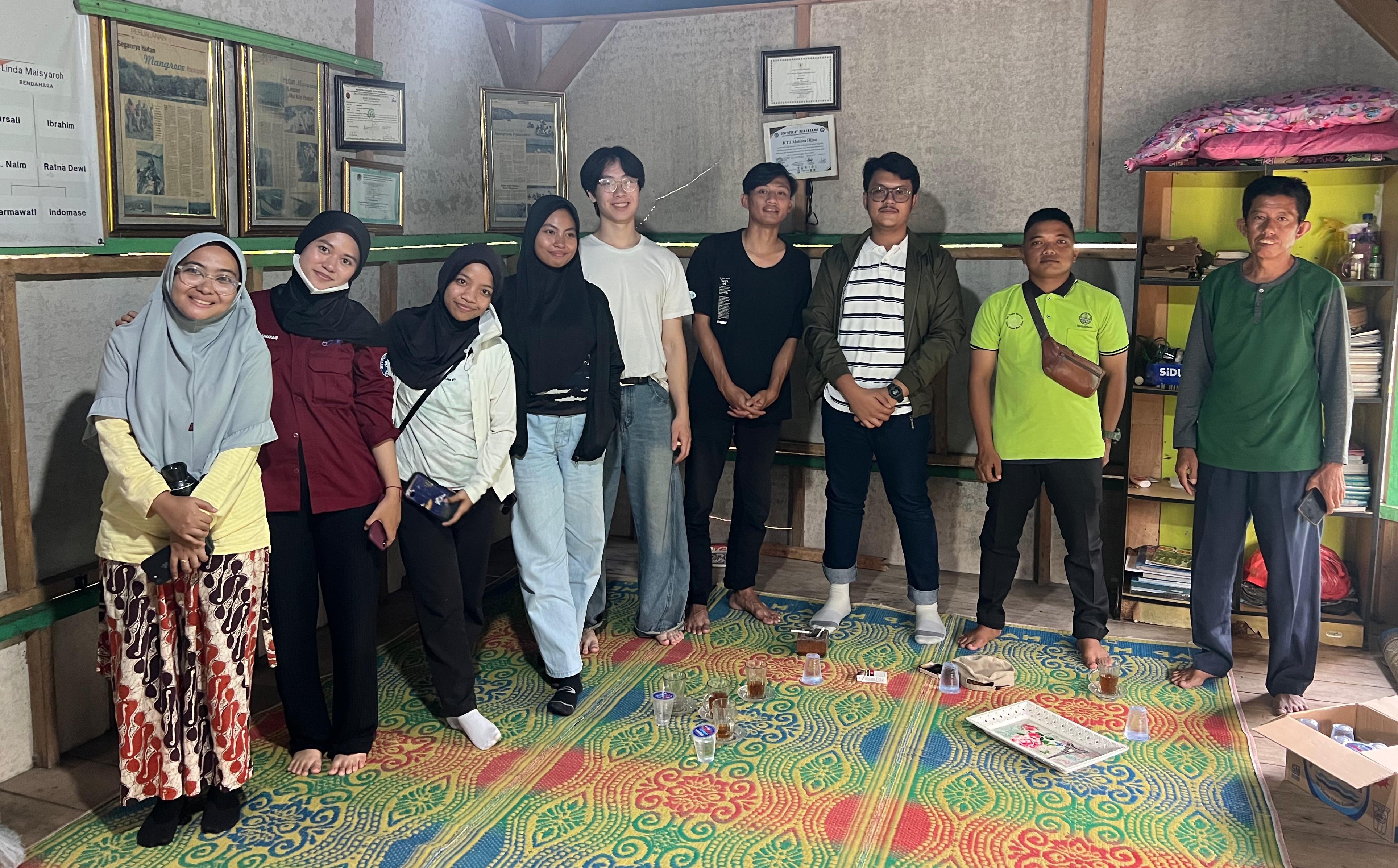
A heartfelt thank you to our amazing contributors who brought their skills, passion, and perspectives to this journey:
- Anisa Fitri Maharani
- Iman Hamdi Aliwikan
- Pungka Sihite
- Raymond
- Sabilla Fatihaturrohmah
- Yuddit Syahfitri
